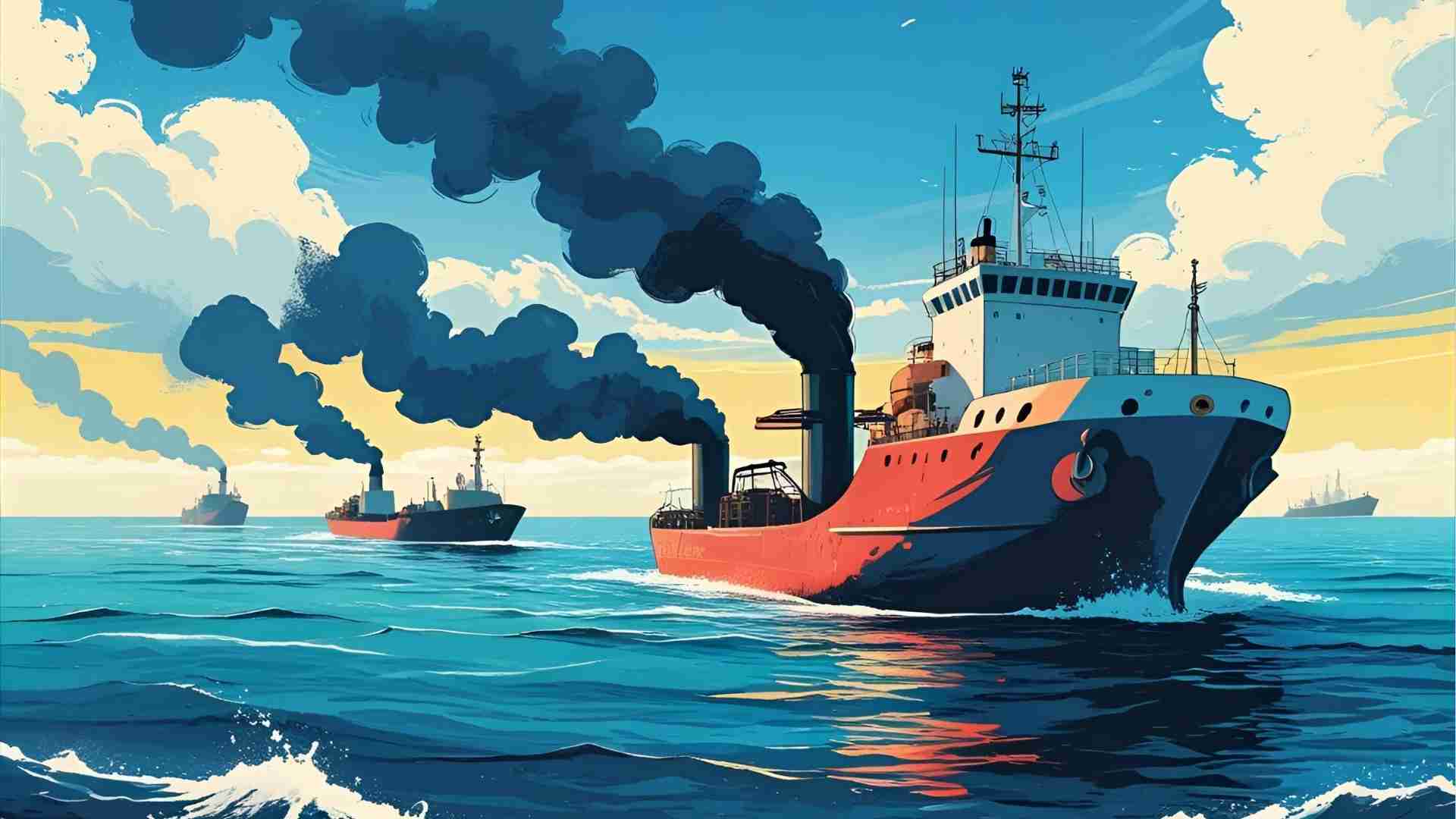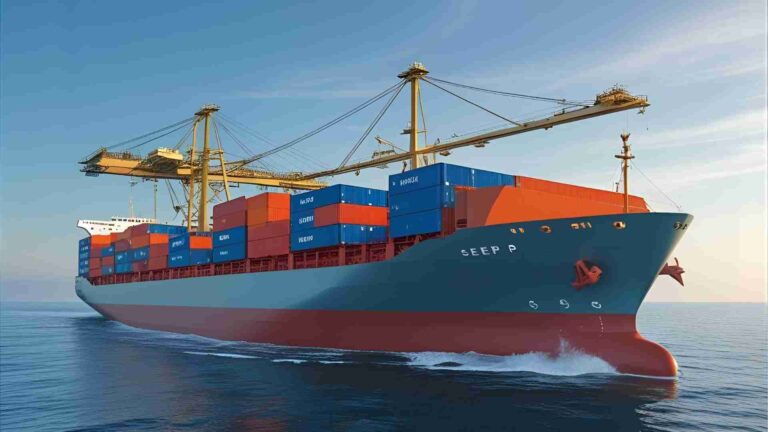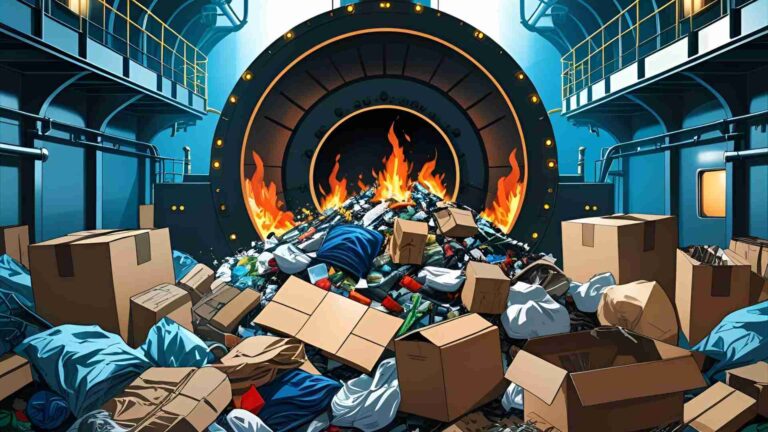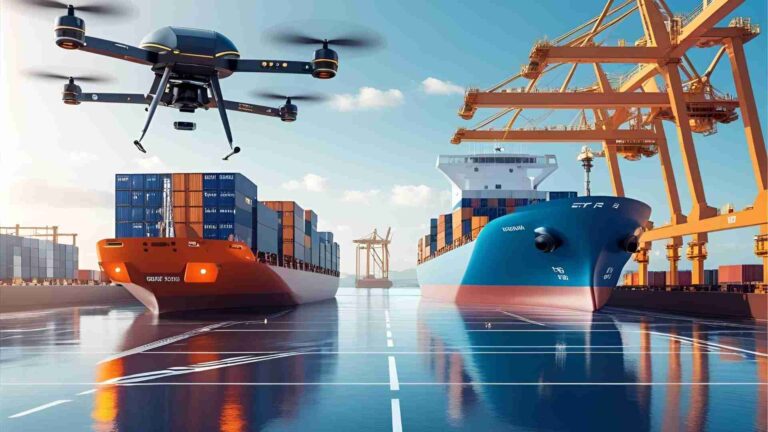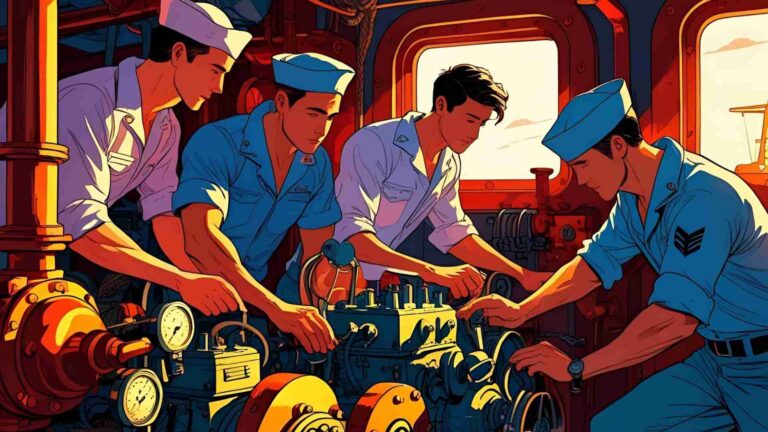Prevention of Pollution by Sewage from Ships
Learn how MARPOL Annex IV prevents sewage pollution from ships with strict discharge standards, treatment systems, and special area regulations.
Marine pollution poses a significant threat to global ecosystems, with sewage discharge from ships contributing to environmental degradation in coastal and offshore waters. The International Maritime Organization (IMO) addresses this issue through MARPOL Annex IV, a critical framework designed to regulate sewage discharge from ships and protect marine environments. This article explores the intricacies of MARPOL Annex IV, detailing its scope, regulations, enforcement mechanisms, and challenges, while emphasizing its role in mitigating the adverse effects of sewage pollution. With a focus on practical compliance and technological solutions, this comprehensive guide aims to inform ship operators, policymakers, and environmentalists about the importance of managing ship-generated sewage responsibly.
Understanding Sewage Pollution from Ships
Sewage from ships, if discharged untreated, can wreak havoc on marine ecosystems. It introduces high concentrations of nitrates, phosphates, and organic matter, leading to oxygen depletion in water bodies. This process, known as eutrophication, fosters algal blooms that suffocate aquatic life and disrupt ecosystems. Additionally, untreated sewage poses health risks to coastal communities and harms industries like tourism and fisheries, particularly in regions with pristine coastal waters.
Sewage from ships is categorized into two types: black water and grey water. Black water includes waste from toilets, urinals, medical facilities, and animal spaces, while grey water encompasses drainage from sinks, showers, galleys, and laundry. Together, these form wastewater, which varies significantly in volume depending on the ship’s size and passenger capacity. For instance, a large cruise ship with thousands of passengers can generate up to 170,000 gallons of sewage daily, equivalent to 0.01 to 0.06 cubic meters per person per day.
The primary sources of sewage pollution are land-based, such as municipal sewer systems and treatment plants. However, ships contribute significantly, especially in high-traffic maritime routes and sensitive coastal areas. MARPOL Annex IV targets this issue by establishing stringent standards for sewage management on ships, ensuring that discharges are controlled to minimize environmental impact.
MARPOL Annex IV: A Framework for Sewage Management
MARPOL, or the International Convention for the Prevention of Pollution from Ships, is a cornerstone of international maritime environmental regulation. Annex IV specifically addresses sewage pollution, setting forth requirements for ships engaged in international voyages. The annex applies to vessels of 400 gross tonnage (GT) and above or those certified to carry more than 15 persons. Its primary goal is to prevent untreated sewage discharge into the sea, particularly near coastal areas, through a combination of equipment standards, discharge regulations, and port reception facilities.
Key Provisions of MARPOL Annex IV
- Scope and Applicability
The regulations target ships involved in international voyages, with thresholds based on tonnage and passenger capacity. Ships below 400 GT but carrying more than 15 persons must also comply, ensuring broad coverage across various vessel types, including cargo ships, passenger ferries, and cruise liners. - Sewage Definition
Sewage under MARPOL Annex IV includes black water (from toilets, urinals, medical facilities, and animal spaces) and grey water when mixed with black water. Notably, grey water alone is not regulated under Annex IV, though local jurisdictions may impose additional restrictions. - Discharge Standards
The discharge of untreated sewage is generally prohibited, with specific exceptions:- Comminuted and Disinfected Sewage: Ships equipped with approved systems can discharge comminuted (broken down) and disinfected sewage at least 3 nautical miles from the nearest land, provided the ship is en route at a minimum speed of 4 knots.
- Untreated Sewage: Discharge is permitted beyond 12 nautical miles from land, at the same minimum speed, with a controlled discharge rate approved by the ship’s administration.
- Sewage Treatment Plants: Ships with approved sewage treatment plants (STPs) can discharge treated effluent anywhere, provided it meets performance standards and does not produce visible floating solids or water discoloration.
DRmax = 0.00926 × V × D × B
Where:- DRmax = Maximum discharge rate (m³/h)
- V = Ship’s average speed (knots)
- D = Draft (m)
- B = Breadth (m)
- Equipment Requirements
Ships must be equipped with one of the following:- Sewage Treatment Plant (STP): An approved system that treats sewage to meet IMO performance standards, certified through the International Sewage Pollution Prevention Certificate (ISPPC).
- Comminuting and Disinfecting System: A system that grinds and disinfects sewage for discharge under specific conditions.
- Holding Tank: A tank to store sewage for later disposal at port reception facilities, equipped with a visual indicator for content levels.
- Special Areas
Certain regions, designated as Special Areas, have stricter sewage discharge regulations due to their ecological sensitivity. The Baltic Sea is currently the only Special Area under Annex IV, with additional requirements for passenger ships, including nitrogen and phosphorus removal standards for STPs. Discharge restrictions in the Baltic Sea took effect in phases:- June 1, 2019, for new passenger ships.
- June 1, 2021, for existing passenger ships.
- June 1, 2023, for existing passenger ships on direct routes outside the Special Area or east of longitude 28°10’ E without intermediate port calls.
- Port Reception Facilities
Governments are obligated to provide adequate port reception facilities for sewage disposal without causing delays to ships. These facilities are critical for ensuring compliance, especially in Special Areas where discharge is heavily restricted. - Enforcement and Compliance
Compliance is enforced through inspections by national authorities and port state control (PSC) officers. Ships must carry a valid ISPPC, and PSC inspections verify proper operation of sewage systems, crew awareness of regulations, and maintenance records. Non-compliance can result in fines, detention, or operational restrictions.
Chart: Sewage Discharge Decision Process
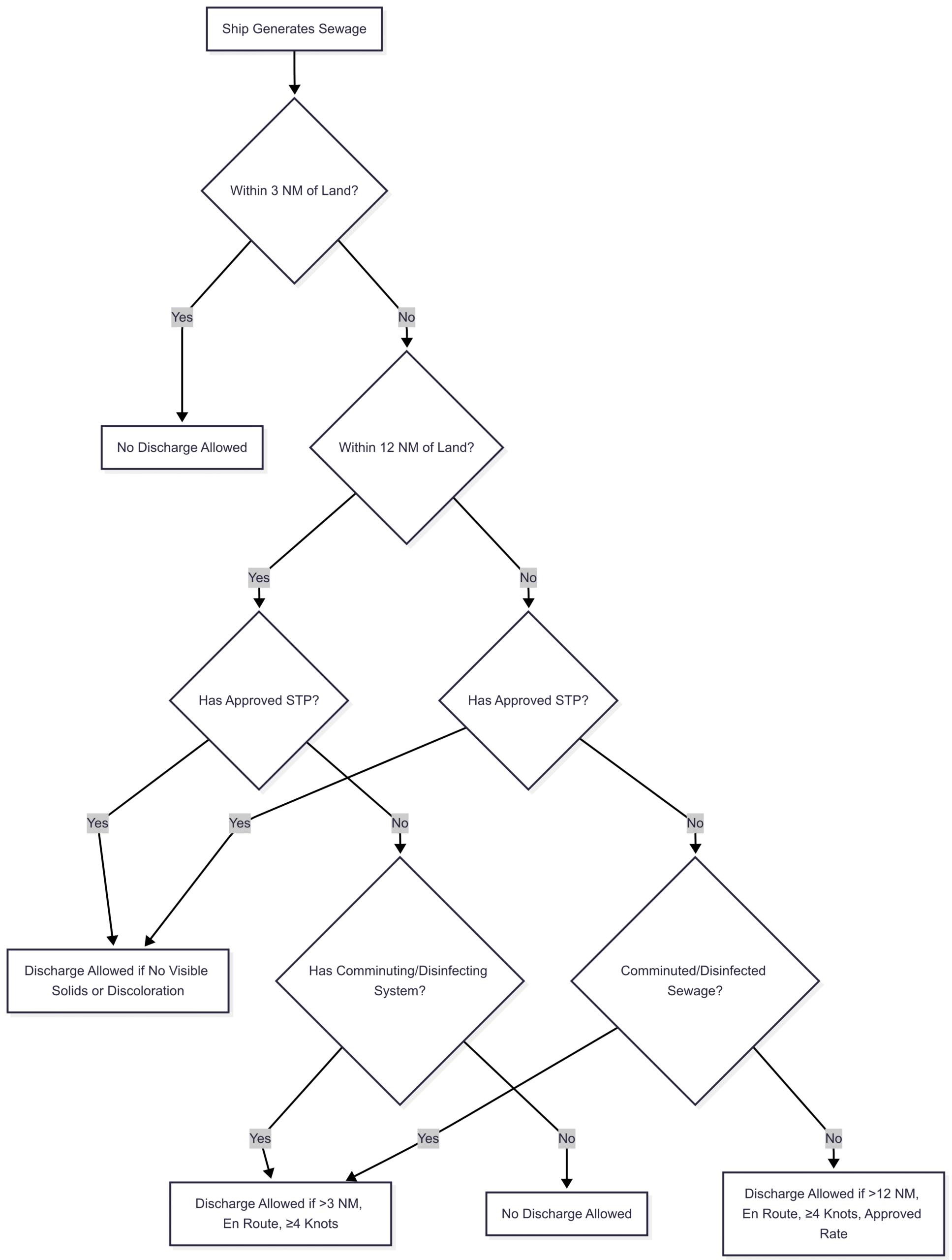
This chart outlines the decision-making process for sewage discharge under MARPOL Annex IV, guiding ship operators on compliance based on location, equipment, and operational status.
Sewage Management Systems on Ships
To comply with MARPOL Annex IV, ships employ various systems to manage sewage effectively. These systems are designed to either treat sewage for safe discharge or store it for shore-based disposal.
1. Sewage Treatment Plants (STPs)
STPs are the most advanced solution, using biological or aerobic digestion to break down sewage. Treated effluent can be discharged anywhere, provided it meets IMO standards. Modern STPs are compact and efficient, with features like:
- Biological Digestion: Bacteria decompose organic matter, reducing nitrates and phosphates.
- Chlorination: Disinfection to eliminate pathogens, typically maintaining 5 ppm chlorine levels.
- Nitrogen and Phosphorus Removal: Mandatory for passenger ships in Special Areas like the Baltic Sea.
2. Comminuting and Disinfecting Systems
These systems grind sewage into smaller particles and disinfect it using chemicals. The treated liquid can be reused for flushing, while solids are stored for shore disposal. Key components include:
- Grinder and Filter: Breaks down solids and separates liquids.
- Chemical Treatment: Disinfects the effluent to eliminate bacteria.
3. Holding Tanks
Holding tanks store untreated sewage for disposal at port reception facilities. Their capacity depends on the ship’s crew size, voyage duration, and operational needs. Tanks are equipped with visual indicators to monitor content levels.
Table: Comparison of Sewage Management Systems
| System | Function | Discharge Conditions | Advantages | Challenges |
|---|---|---|---|---|
| Sewage Treatment Plant (STP) | Treats sewage biologically | Anywhere, if meets IMO standards | Flexible discharge, environmentally friendly | High maintenance, bacterial sensitivity |
| Comminuting/Disinfecting | Grinds and disinfects sewage | >3 NM, en route, ≥4 knots | Cost-effective, reusable effluent | Limited discharge zones, solid storage |
| Holding Tank | Stores sewage for shore disposal | No discharge; shore facility required | Simple, reliable | Limited capacity, reliance on ports |
Challenges in Sewage Management
Despite the robust framework of MARPOL Annex IV, several challenges persist in managing ship-generated sewage:
- Non-Covered Vessels: The annex does not apply to ships with fewer than 15 persons or those under 400 GT, such as domestic ferries and recreational yachts. These vessels contribute significantly to pollution in tourist-heavy regions.
- System Failures: Common issues include:
- Clogging of pipes and filters due to non-biodegradable items like plastics or rags.
- Corrosion in sewage pipes, leading to leaks or blockages.
- Loss of vacuum in systems, affecting operation.
- Bacterial die-off in biological STPs due to improper cleaning agents or inadequate aeration.
- Crew Training: Inadequate training can lead to improper operation of sewage systems, such as flushing non-biodegradable items or using unapproved chemicals, which can kill bacteria in STPs.
- Port Reception Facilities: Inconsistent availability or capacity of port facilities can hinder compliance, especially in developing regions or busy ports.
- Grey Water Regulation: The lack of international standards for grey water allows untreated discharge in many areas, undermining overall pollution control efforts.
Enforcement and Port State Control (PSC)
PSC inspections are critical for ensuring compliance with MARPOL Annex IV. Inspectors focus on:
- Operational Checks: Verifying that STPs or holding tanks function correctly.
- Crew Knowledge: Ensuring crew members understand international and local regulations.
- Documentation: Reviewing the ISPPC and maintenance logs.
- Physical Inspection: Checking for corrosion, leaks, or improper valve operations.
- Chlorine Levels: Testing effluent for adequate disinfection (typically 5 ppm chlorine).
Non-compliance can lead to penalties, including fines, ship detention, or restrictions on operations. For ships without STPs, PSC verifies the use of holding tanks and proper shore disposal through standard discharge connections (outer diameter: 215 mm, bolt circle diameter: 183 mm, 6 bolts of 20 mm diameter).
Special Areas: The Baltic Sea Case Study
The Baltic Sea, the only Special Area under Annex IV, exemplifies the need for stringent regulations. Its enclosed nature and heavy maritime traffic make it vulnerable to pollution. The phased implementation of discharge bans for passenger ships reflects a tailored approach to protect this sensitive ecosystem. Passenger ships must use STPs meeting nitrogen and phosphorus removal standards, significantly reducing nutrient loads that cause eutrophication.
Chart: Baltic Sea Sewage Discharge Timeline

This chart illustrates the phased implementation of sewage discharge restrictions in the Baltic Sea, highlighting compliance deadlines for different ship categories.
Voluntary Compliance and Global Adoption
For non-signatory countries, such as the United States, ships can obtain a Statement of Voluntary Compliance (SOVC) to align with MARPOL Annex IV standards. This voluntary adherence enhances global consistency in sewage management and supports environmental protection efforts. However, broader adoption of Annex IV by all maritime nations remains crucial for comprehensive pollution control.
Future Directions and Recommendations
To strengthen MARPOL Annex IV and address its shortcomings, several measures can be considered:
- Expand Coverage: Include smaller vessels and recreational boats under regulatory frameworks to reduce unregulated sewage discharge.
- Standardize Grey Water: Develop international standards for grey water management to close regulatory gaps.
- Enhance Port Facilities: Invest in global port reception infrastructure to support compliance, particularly in developing regions.
- Crew Training Programs: Implement mandatory training on sewage system operation and maintenance to reduce human error.
- Technological Advancements: Promote research into compact, efficient STPs with lower maintenance requirements and resilience to operational challenges.
Conclusion
MARPOL Annex IV plays a pivotal role in mitigating sewage pollution from ships, safeguarding marine ecosystems and coastal economies. By setting stringent standards for sewage treatment, discharge, and port facilities, it ensures that ships operate responsibly in international waters. However, challenges like unregulated vessels, system failures, and inconsistent port infrastructure highlight the need for ongoing improvements. Through enhanced regulations, technological innovation, and global cooperation, the maritime industry can further reduce its environmental footprint, preserving the oceans for future generations.
Happy Boating!
Share Prevention of Pollution by Sewage from Ships with your friends and leave a comment below with your thoughts.
Read An Overview Of Sludge And Bilge Management Onboard Ships until we meet in the next article.
